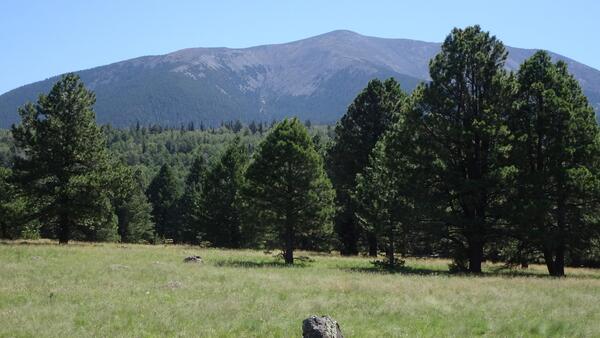Mountain Flora
"Mountains know secrets we need to learn. That it might take time, it might be hard, but if you just hold on long enough, you will find strength to rise up" – Tyler Knott
Escaping the ebb and flow of ice sheets during the Pleistocene, our desert sky islands are populated by vagabonds from the north. Sometimes referred to as the Arcto-tertiary flora, these travelers are species that have their genetic roots to the north.
However, they are only part of the story. There are also species living on these sky islands with their genetic roots in the south, the Madro-tertiary flora, named after the Sierra Madre the “mother mountains” in Mexico. Prior to the Pleistocene there was the Pliocene and Miocene, grouped together as the Tertiary or Neogene, going back 3.6 to 23 million years ago. Using fossils, we can trace the origins of our current plant assemblages back to these times; hence we can identify particular species and species assemblages with either the Madro-tertiary or Arcto-tertiary floras.
Generally, conifers and conifer-associated shrubs, perennials and annuals represent the Arcto-tertiary flora. Species whose current distributions extend up the Sierra Nevada and Cascade ranges, or up into the Rocky Mountains into Canada. The Madro-tertiary flora is comprised of species from warm, subtropical climates. They include chaparral species such as Manzanita, Ceanothus, Rhus (sugar bush and skunk bush sumac), and Garrya (silk tassel). They also include higher elevation species such as live, evergreen oaks, and Cercocarpus (mountain mahogany), as well as lower elevation, true desert species, such as ocotillo, Yucca, Nolina, Agave, and cacti. During the seasonal droughts of the semi-tropics these species fine-tuned their abilities to survive and thrive without a regular, constant supply of water. As the Sierra Nevada and Peninsular Mountain ranges began to rise during the Tertiary, they created a growing rain shadow, leaving an increasingly arid landscape to their leeward side. Those arid lands created an opportunity for the drought-adapted Madro-tertiary flora to exploit. Those adaptations included thick, often waxy, wilt-resistant leaves (live oaks, Manzanita, Rhus, Yucca, Nolina, and Agave), drought-deciduous leaves (ocotillo), or no leaves at all (cacti).
Cacti are believed to have evolved as epiphytes, grasping to the branches of subtropical and tropical trees. The tropics are notable for being hot and wet, but portions of the tropics have seasonal dry periods, and even when rain does fall if you live clinging to tree branches with no soil to trap and store rainwater, you live where it is effectively very dry. In lieu of soil, cacti evolved thick spongy stems to store water. As the aridity deepened across the rain-shadowed southwestern North America, cacti were quick to exploit this new landscape. They evolved diminutive forms such as Mammillaria, and giants such as saguaros and cardons.
On the uppermost cold slopes of sky islands, conifers are king. On the warmer, drier, lower slopes, the Madro-tertiary assemblage of plant species is dominant. Somewhere in the middle there is a mixing zone where both groups mingle. With both increasing temperatures and aridity these current zones will likely change, however predicting just how they will shift can be challenging. One scenario is that with increasing aridity wildfires will become more intense and larger. Sound familiar? Oaks can quickly sprout from their roots after fires, whereas conifers depend on seeds to reestablish themselves. In July 2013, in the San Jacinto Mountain region a wildfire, the “Mountain Fire,” raged up from Mountain Center toward Spitler Peak and beyond. Prior to the fire, along the Spitler Peak trail naturalists would first encounter ribbonwood, then Coulter pine, Jeffry pine, sugar pine, possibly ponderosa pine, white fir, incense cedar, black oak, and canyon live oak. Now, nine years after the fire, there are thick stands of ribbonwood, oaks (both species), cholla cacti, manzanita, and just a very a few Coulter pines. The obvious representatives of the Arcto-tertiary flora are almost gone. If this pattern is indicative of a more widespread future, then plants with those Madro-tertiary origins appear to be winners of this human-generated shift in climate and the associated intensity and size of wildfires.
Nullius in verba
Go outside, tip your hat to a chuckwalla (and a cactus), think like a mountain, and be safe
